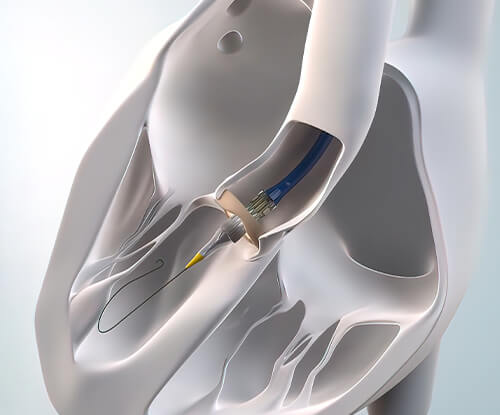Cardiovascular
Call Us
Get a Free Consultation
Cardiovascular
Heart valve Replacements with Closed Surgery
Valve replacement surgery may be an option if the valves of your heart are too fragile, scarred, or otherwise damaged as Diseased heart valves aren’t always able to perform the job as well as they should.
Heart Failure and Rhythm Disorders
An arrhythmia is a disorder that affects the normal heart rate causing the heart to beat too slow (bradycardia), too fast (tachycardia), or irregularly. These disorders can affect the amount of blood pumped by the heart.
Pacemaker Implantable
A pacemaker is a small device that’s placed (implanted) in the chest to help control the heartbeat. It’s used to prevent the heart from beating too slowly. Implanting a pacemaker in the chest requires a surgical procedure
Implantable Cardioverter – Defibrillators (ICD)
An implantable cardioverter-defibrillator (ICD) is a small electronic device connected to the heart. It is used to continuously monitor and help regulate potentially fast and life-threatening electrical problems with the heart.
TAVI (Transcatheter aortic valve implantation)
A TAVI is a medical procedure that involves fitting a valve into the heart to treat aortic stenosis. During this minimally invasive procedure, a new valve is inserted without removing the old, damaged valve. The new valve is placed inside the diseased valve.
Closed Surgery for Balloon Formation in The Thoracic and Abdominal Aorta (Aneurysm of Aorta), EVAR+TEVAR
It is a surgery used to treat an abdominal aortic aneurysm (AAA). For a patient with a thoracic aortic aneurysm (aneurysm in the chest area), the procedure is termed thoracic endovascular aortic aneurysm repair (TEVAR)
Aesthetic treatment for varices and capillaries Surgery
Surgical techniques to treat varicose veins include ligation (tying off of a vein) and stripping (removal of a long segment of the vein). Traditional vein stripping and ligation involve tying veins shut and removing them through small cuts in your skin.
Coronary Artery Diseases(bypass), non-invasive Cardiac Surgery
Due to many reasons, Cholesterol-containing deposits (plaques) are formed in your coronary arteries as well as inflammation-causing coronary artery disease develops. In this case, the major blood vessels that supply your heart become damaged or diseased. And could result in a heart attack.
Valvular Heart Disease, Pediatric and Congenital Heart Holes (ASD, VSD, PDA)
An atrial septal defect (ASD) is a hole in the wall between the heart’s two upper chambers. ASD is a congenital condition, which means it is present at birth.
A ventricular septal defect (VSD) is a hole in the wall between the two lower chambers. In children, a VSD is usually congenital.
Contact Us

Related Surgeries
VMH Hospitals

Our long-standing experience for years in providing outstanding medical services and high quality

